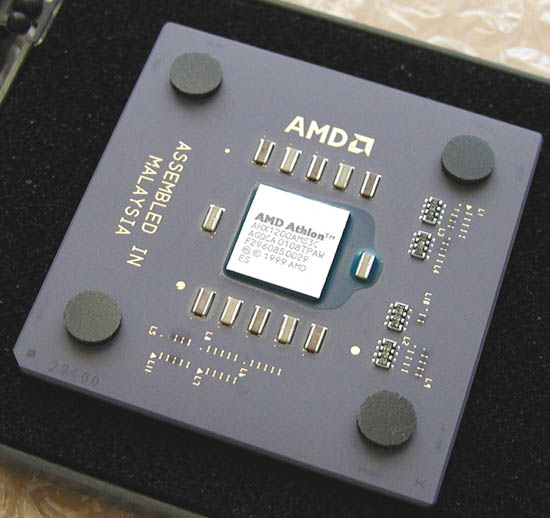 |
|
|
|
In the Forums... |
Posted: June 5th, 2001 Written by: Tuan "Solace" Nguyen The Athlon MP Below is a profile shot of the new Athlon MP processor (Palomino core) based on a 0.18u processor.  The design of the Athlon MP has some new features that its older Thunderbird brother does not, including more bridges and a larger core. The increase in core size is consequent from all the new features that are included in the Athlon MP. The socket interface still remains Socket A, but I wouldnít recommend going out and purchasing an Athlon MP and installing it into your KT133/A system. So why exactly is the Athlon MP being released at 1.2GHz instead of speeds like 1.4GHz? This is because precise timing is more crucial to stability in a MP system than in a single processor system. When things get tweaked and tuned, weíll see faster Athlon MPs make it to the market. The System Below is a picture of a system with dual MP Athlon 4 processors using the Tyan Thunder K7 motherboard.  The specs of the Thunder K7 are as follows: Dual Athlon 4 support, five 64bit PCI slots, one AGP Pro 4X slot, dual onboard 3Com 100Mbps Ethernet controllers, Ultra160 dual channel SCSI controller, four DDR DIMM slots, onboard ATI RageXL graphics accelerator, and 8 cooling fan connectors. You can tell the Thunder K7 isnít your typical PC motherboard. With all those 64bit PCI slots, you can use high-end SCSI controllers that usually come ready to take advantage of the wider bus. Here we see that Tyan has implemented a complete set of 64bit PCI slots not leaving one to spare. There arenít many devices out there that really take advantage of the increased bandwidth except for enterprise level SCSI controllers and gigabit LAN adapters that can pump 100MB of data per second through the bus and LAN. You can already begin to see the immediate limitations of 33MHz/32bit PCI buses as a single gigabit adapter already sucks up about 75% of available bandwidth leaving only 33MB/sec bandwidth for whatever devices are left. Considering that the Thunder K7 is a server board, it will undoubtedly make use of its onboard Ultra160 SCSI connectors that also happen to share the same PCI bus. If a blazing RAID 0 setup were to be used, even the 33MHz/64bit PCI slots here will run out of steam. AMD realizes this limitation and will resolve it in 762MP. In the picture above, you also notice that the ATX power cable that connects the power supply to the motherboard is a little bigger than the usual connector that you and I are familiar with. The one that is commonly use adhere to the ATX 2.x standard but the Tyan Thunder K7 requires a power supply that is of WTX standard. There are 4 extra pins in the main power connector and there is another 3x12v power connector by the CPUs. This connector is necessary to provide enough power for the system to operate. Considering there are 8 fan connectors, a 110w AGP Pro110 slot, and enough on board features for the board to operate without requiring any add-in cards at all, Iím not surprised at the heavy power requirements. A 460watt power supply is highly recommended. So is there no hope for using a 760MP system with your current power supply and case? Of course there is, just not with Tyanís board. Other manufacturers like MSI and Abit are readying 762MPX chipsets that are ATX compliant to remain compatible. These boards will also be cheaper and should come to market at around the $200USD mark making home MP systems extremely attractive. |
||
|
| |||
|---|---|---|---|